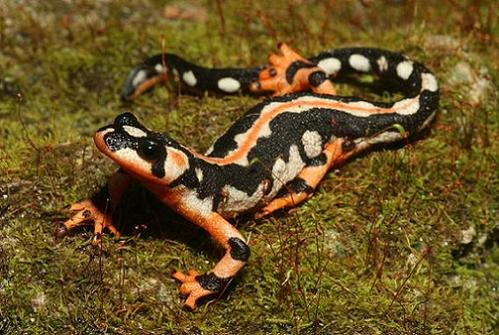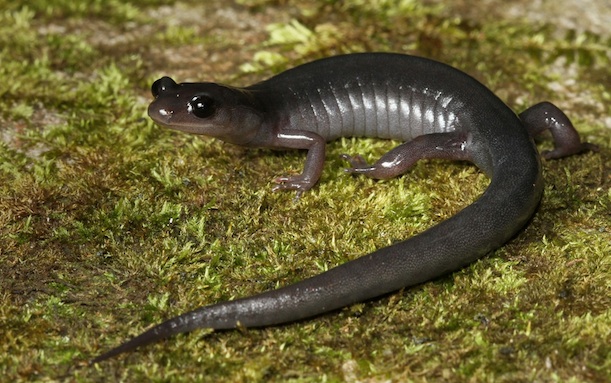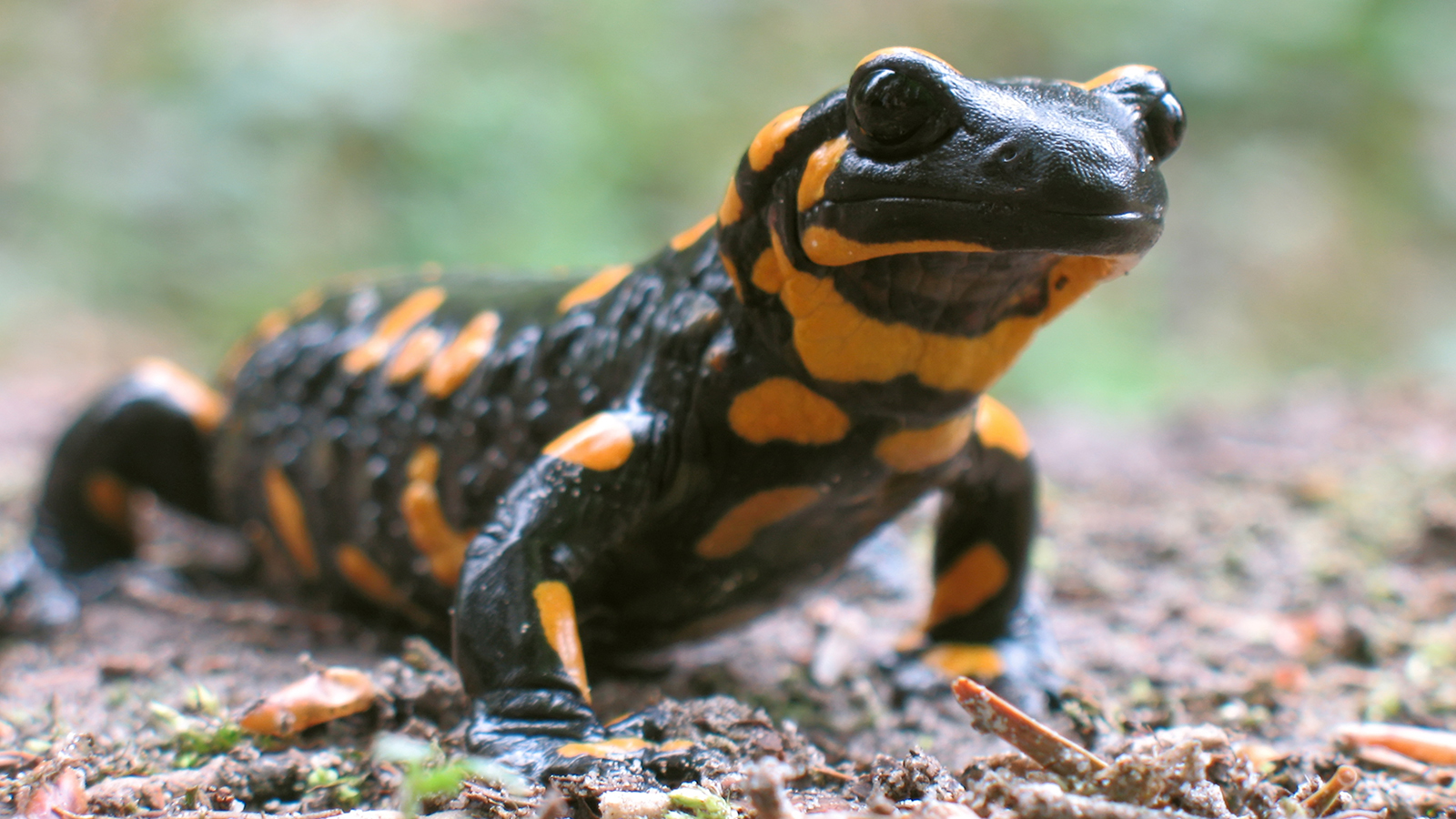
Salamanders and newts comprise one of three
groups of amphibians living today. The other
two, the caecilians (Gymnophiona) and the frogs
and toads (Anura) can be readily distinguished by
their body forms. Like other amphibians, salamanders
and newts have glandular skin that lacks
scales, feathers, or hair. Considering only species
living today, salamanders and newts are a small
group compared to the number of species of frogs
and toads. Whereas frogs and toads are represented
by about four thousand species, only about
four hundred species of salamanders and newts
are living today.
Systematists, biologists who study the classification
of plants and animals, recognize ten families
of salamanders. Newts are simply salamanders
that are classified in the family Salamandridae;
they can be distinguished fromother salamanders
by many osteological (bony) features and by their
generally rough skin, compared to the smooth
skin of other salamanders.
Anatomy of Salamanders and Newts
Salamanders have long, lizardlike bodies with
long tails and four small legs. Many species have
costal grooves along the sides of the body; the
number of these grooves varies among species
and can help with identification. Olfaction (sense
of smell) is used during courtship, and males of
many species have specialized glands on the
body. Males of many species of lungless salamanders
have a gland on the chin that is used to deliver
hormones to the female during courtship.
Salamanders have a larval stage, but unlike
frogs and toads, in which the tadpole is very different
from the adult frog, larval salamanders are
similar in body form to adults. Larval forms are
frequently found in water and retain external
gills, which are lost at metamorphosis (transformation
to the adult stage). Species that breed in
ponds, where oxygen levels are low, have large,
bushy gills for added surface area to increase the
intake of oxygen. In contrast, species that breed in
streams, which have high oxygen levels, have larvae
with short gills. One of the most successful groups of salamanders
are the Plethodontidae, the lungless salamanders.
Most species of these salamanders live
and breed on land, never entering water. They
have no lungs, and oxygen uptake occurs primarily
through the thin, porous skin. One requirement
for this gaseous exchange is moisture, and
these salamanders live primarily in damp, cool
forests.
Life History of Salamanders and Newts
Primitive families of salamanders deposit eggs in
water and have aquatic larvae. Other families of
salamanders are unique among amphibians in
producing a spermatophore for the transfer of
sperm from the male to the female. The spermatophore
is a gelatinous structure with a sperm
cap resembling a tiny mushroom. The spermatophore
is transferred from the male to the female in
an elaborate courtship ritual. In some species, the
male rubs secretions from a gland under his chin
over the body of the female and entices her to follow
him about. He then deposits a spermatophore
on the substrate of the pond, which the female
straddles and picks up with her cloaca. Fertilization
is therefore internal in those species that produce
a spermatophore.
Lungless salamanders are active on the forest
floor during moist or humid periods. Males are
antagonistic to one another and appear to establish
small territories that they defend from other
males. The territorial encounters include biting
and chasing and can result in injuries, including
loss of part of the tail.
Defense Against Predators
Like other amphibians, salamanders and newts
have toxic skin secretions produced by skin
glands that are used in various ways as defense
mechanisms to repel predators. In some species of
newts, glands are concentrated
on the dorsum, and
when disturbed by a predator,
the salamander displays an
"unken reflex." This display
includes bending the body in a
U-shape and showing bright
coloration of the underbelly.
At the same time, the animal
becomes immobile, thus decreasing
the chance that a
predator will attack. Other
species have glands concentrated
on the tail and engage in
tail lashing or tail undulation.
In tail lashing, the salamander
violently whips its tail toward
the predator, which attacks the
tail and tastes the noxious secretions.
In tail undulation,
the body of the salamander remains
immobile while the tail
is waved in a sinuous fashion
above the body. The tail in
these species can be autotomized,
or broken from the
body by the salamander. Thus, if a predator attacks
the waving tail, the salamander loses the tail
but escapes with its life.
Other species actively defend themselves if attacked
by a predator. Amphiumas are large, powerful
salamanders that live in ponds, swamps, or
marshes in the southeast United States. Adults
reach one meter in length and can inflict a painful
bite with their sharp teeth. In a unique manner of
defense, slender salamanders can secrete copious
amounts of an adhesive substance from their
glands. When attacked by a garter snake, the salamander's
secretions glue the snake's body to itself,
and it is unable to swallow the salamander.
Salamander and Newt Facts
Classification:
Kingdom: Animalia
Phylum: Vertebrata
Class: Amphibia
Order: Caudata
Families: Ten families, including Ambystomatidae (mole salamanders),
Amphiumidae (amphiumas), Cryptobranchidae (hellbender and
giant salamanders), Dicamptodontidae (Pacific giant salamanders),
Plethodontidae (lungless salamanders), Proteidae (waterdogs and
mudpuppies), Rhyacotritonidae (torrent salamanders), Salamandridae
(newts), Sirenidae (sirens)
Geographical location: Eurasia and North America, with one family
extending into South America
Habitat: Many habitats, including forests, savannas, prairies, freshwater
ponds and streams, and ephemeral pools
Gestational period: Varies among species; species that breed in ponds
have larval stages that last two to six months, whereas the larval
stage of stream-breeding species may last several years
Life span: Varies among species; larger species tend to live longer than
smaller ones; large aquatic salamanders have lived for fifty to fiftyfive
years in captivity
Special anatomy: Long body with long tail and four legs; some species
are legless
Other popular Animals
Photo Gallery of - Salamander and Newt








 Animalia Life
Animalia Life